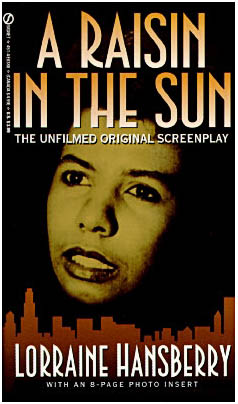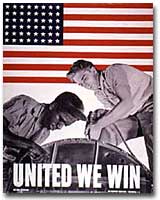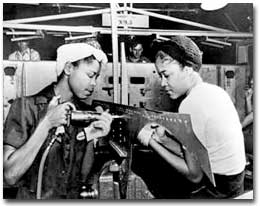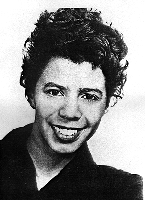
|
Desegregation and the Civil Rights Movement |

|

|
Desegregation and the Civil Rights Movement |

|
The play A Raisin in the Sun is an American classic. The central conflict of the play is the tension surrounding one familyÕs decision to move to the suburbs as a symbolic act of desegregation. In this lesson we will look at some of the national struggles over desegregation and examine how these issues are apparent in the play by Lorraine Hansberry.

| Segregation
and Desegregation Theme, title, and characters of A Raisin in the Sun Lorraine Hansberry Critical response to African American plays |
 Blacks
participated in WWII for the first time in a non-segregated army. African Americans
served in every branch of the military and in every theater of conflict. Returning
to the United States after fighting abroad, they sought to integrate into American
lifestyles. Moving to the suburbs from the overcrowded inner cities was a part
of the new American dream. New technology was popular as people acquired TVs
and refrigerators and other household appliances. The Younger family of A Raisin
in the Sun represents the working class trying to become a part of the new middle
class lifestyles.
Blacks
participated in WWII for the first time in a non-segregated army. African Americans
served in every branch of the military and in every theater of conflict. Returning
to the United States after fighting abroad, they sought to integrate into American
lifestyles. Moving to the suburbs from the overcrowded inner cities was a part
of the new American dream. New technology was popular as people acquired TVs
and refrigerators and other household appliances. The Younger family of A Raisin
in the Sun represents the working class trying to become a part of the new middle
class lifestyles.
At the same time the play
points to the burgeoning civil rights movement. Racial segregation had just
been declared illegal. Restrictive housing covenant were eliminated and in 1954, the Brown
versus the Board of Education case prohibited segregation in the public
schools. Blacks were struggling for a sense of equality and acknowledgement
(Wilkerson, 121; Africana "World War II and African Americans.").
covenant were eliminated and in 1954, the Brown
versus the Board of Education case prohibited segregation in the public
schools. Blacks were struggling for a sense of equality and acknowledgement
(Wilkerson, 121; Africana "World War II and African Americans.").
![]()
 Lorraine
Hansberry was born in Chicago, the daughter of a prominent real estate
broker. She studied at the University of Wisonsin, and later moved to Harlem
to work with Paul Robeson editing a magazine. There she met her husband, Robert
Nemiroff who assisted her in her artistic efforts. In 1959 she won the Drama
Critics Circle Award for her play and became the first African American woman
writer whose play was staged on Broadway.
Lorraine
Hansberry was born in Chicago, the daughter of a prominent real estate
broker. She studied at the University of Wisonsin, and later moved to Harlem
to work with Paul Robeson editing a magazine. There she met her husband, Robert
Nemiroff who assisted her in her artistic efforts. In 1959 she won the Drama
Critics Circle Award for her play and became the first African American woman
writer whose play was staged on Broadway.
A Raisin in the Sun was an exceptional realistic drama about a Black family living in the poorest section of Chicago. In the play, three generations of family members struggle to adapt to the new world that surrounds them. Finding funding for the first production of the play was difficult. Hansberry and her husband raised $100,000 with the help of friends, supporters, and actors like Sidney Poitier. After out of town tryouts in New Haven, Chicago, and Philadelphia, the play opened on Broadway to mixed reviews.
Compare and contrast the following excerpts from newspaper reviews:
"Gives a Wonderful Emotional Evening,"
There are high tidings in the neighborhood of the Ethel Barrymore Theatre today, for a small hunk of history was made there last night. A play be a Negro about Negroes with an almost all-Negro cast opened on Broadway and was a stupendous un-segregated hit.
It proved to me at least that when these people create and participate in something for themselves they can make the rest of us look silly.
The absolute honesty of the speech and behavior of the characters was most impressive. There are no "Uncle Toms" involved, and on the other hand there are no self-conscious intellectuals; there is no condescension and no humility and no abnormal exploitation of the current racial problems. It is a straightforward story well told. (McClain, John. New York Journal American March 12, 1959)
"A Raisin in the Sun a Glowingly Lovely and Touching Little Play"
Lorraine HansberryÕs "A Raisin in the Sun" which was presented at the Ethel Barrymore Theatre, is a beautiful, loveable play. It is affectionately human, funny and touching, and it is acted by a company of actors who really are a company and not just a set of players. This is not a big play and probably not even an important one, but even so it is a work of theatrical magic in which the usual barrier between audience and stage disappears; the people up there are living among us and we down here are mixing with those up there on easy terms.
This happy blend of script, cast and audience is not achieved very often, and when it does come about it shows us what the theater should be at its best. It can make something important out of something slight and simple.
"A Raisin in the Sun" is slight and simple enough, being the story of a hard-working Chicago family which forgets its petty differences and becomes a unitÑa brave one tooÑwhen it is brushed by disappointment and near disaster. ItÕs great appeal lies in its affection and understanding, rather than in the mechanics of telling a storyÉ.
The family, in losing much of its fortune and most of its hopes, gains something greaterÑits pride. As Poitier proudly points out in the closing scene, his little boy represents the sixth generation of Americans who have been able to take care of themselves. ItÕs a lovely play. (Chapman, John. Daily News, March 12, 1959)
![]()
When Hansberry first wrote the play, she titled it "The Crystal Stair" based upon the last line of Langston HughesÕ poem Mother to Son. Later, she re-titled the play and began with another poem by Hughes called A Dream Deferred. Read these two poems and compare and contrast their content.
Crystal Stair
Well,
son IÕll tell you:
Life for me ainÕt been no crystal stair
ItÕs had tacks in it,
And splinters,
And boards torn up,
And places with no carpet in the floorÑ
Bare.
But all the time
IÕse been a-climbin on,
And reachinÕ landinÕ s,
And turninÕcorners
And sometimes goinÕ in the dark
Where there ainÕt been no light.
So boy, donÕt you turn back
DonÕt you set down on the steps
ÔCause you find it kinder hard.
DonÕt you fall nowÑ
For IÕse still goinÕ, honey
IÕse still climbinÕ,
And life for me ainÕt been no crystal stair.
A Dream Deferred
What happens
to a dream deferred?
Does it dry up Like a raisin in the sun?
Or fester like soreÑ
And then run?
Does it stink like rotten meat?
Or crust and sugar overÑ
Like a syrupy sweet?
Maybe
it just sags
Like a heavy load.
Or does it explode?
A Raisin in the Sun was republished in 1984 with added scenes that were eliminated from the original Broadway production. In class we will discuss why the producers may have cut these scenes.
1) The two poems Crystal Stair and A Dream Deferred convey very different messages about Black life and lifestyles. Does the theme of the poem A Dream Deferred reflect the action of the play more that the poem Crystal Stair? Why or Why not?2) Do you think that the move to the suburbs will really be a step up for the Younegr family?
3) Who are the characters in A Raisin in the Sun, and which aspect of the African American dream does each of them represent? (How is the dream deferred for each of them?)
- Ruth
- Walter
- Lena
- Beneatha
- Asagai
- Travis
4) Why do you think that the original critical response to the play was so mixed?
|
[Home]
|
Copyrighted
2001, United States
of America
Anita Gonzalez & Ian Granick